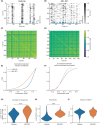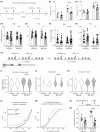Correlation between desynchrony of hippocampal neural activity and hyperlocomotion in the model mice of schizophrenia and therapeutic effects of aripiprazole
- PMID: 38702935
- PMCID: PMC11069053
- DOI: 10.1111/cns.14739
Correlation between desynchrony of hippocampal neural activity and hyperlocomotion in the model mice of schizophrenia and therapeutic effects of aripiprazole
Abstract
Aims: The hippocampus has been reported to be morphologically and neurochemically altered in schizophrenia (SZ). Hyperlocomotion is a characteristic SZ-associated behavioral phenotype, which is associated with dysregulated dopamine system function induced by hippocampal hyperactivity. However, the neural mechanism of hippocampus underlying hyperlocomotion remains largely unclear.
Methods: Mouse pups were injected with N-methyl-D-aspartate receptor antagonist (MK-801) or vehicle twice daily on postnatal days (PND) 7-11. In the adulthood phase, one cohort of mice underwent electrode implantation in field CA1 of the hippocampus for the recording local field potentials and spike activity. A separate cohort of mice underwent surgery to allow for calcium imaging of the hippocampus while monitoring the locomotion. Lastly, the effects of atypical antipsychotic (aripiprazole, ARI) were evaluated on hippocampal neural activity.
Results: We found that the hippocampal theta oscillations were enhanced in MK-801-treated mice, but the correlation coefficient between the hippocampal spiking activity and theta oscillation was reduced. Consistently, although the rate and amplitude of calcium transients of hippocampal neurons were increased, their synchrony and correlation to locomotion speed were disrupted. ARI ameliorated perturbations produced by the postnatal MK-801 treatment.
Conclusions: These results suggest that the disruption of neural coordination may underly the neuropathological mechanism for hyperlocomotion of SZ.
Keywords: aripiprazole; hippocampus; hyperlocomotion; neural activity; schizophrenia.
© 2024 The Authors. CNS Neuroscience & Therapeutics published by John Wiley & Sons Ltd.
Conflict of interest statement
The authors declare no competing financial interests.
Figures





Similar articles
-
Rhythmic theta and delta activity of cortical and hippocampal neuronal networks in genetically or pharmacologically induced N-methyl-D-aspartate receptor hypofunction under urethane anesthesia.Neuroscience. 2013 May 1;237:255-67. doi: 10.1016/j.neuroscience.2013.01.058. Epub 2013 Feb 8. Neuroscience. 2013. PMID: 23396086
-
Exaggerated MK-801-induced motor hyperactivity in rats with the neonatal lesion of the ventral hippocampus.Behav Pharmacol. 2000 Jun;11(3-4):269-78. doi: 10.1097/00008877-200006000-00010. Behav Pharmacol. 2000. PMID: 11103881
-
Septohippocampal GABAergic neurons mediate the altered behaviors induced by n-methyl-D-aspartate receptor antagonists.Hippocampus. 2012 Dec;22(12):2208-18. doi: 10.1002/hipo.22039. Epub 2012 May 17. Hippocampus. 2012. PMID: 22592894
-
Combined treatment with aripiprazole and antidepressants reversed some MK-801-induced schizophrenia-like symptoms in mice.Pharmacol Rep. 2018 Aug;70(4):623-630. doi: 10.1016/j.pharep.2018.02.022. Epub 2018 Feb 24. Pharmacol Rep. 2018. PMID: 29885435
-
Medial septum modulates hippocampal gamma activity and prepulse inhibition in an N-methyl-d-aspartate receptor antagonist model of schizophrenia.Schizophr Res. 2018 Aug;198:36-44. doi: 10.1016/j.schres.2017.07.053. Epub 2017 Aug 8. Schizophr Res. 2018. PMID: 28801194 Review.
Cited by
-
Lack of Efficacy of Simvastatin Adjunctive Therapy for Patients with Schizophrenia: A Meta-Analysis of Randomized Controlled Trials.Neuropsychiatr Dis Treat. 2024 Sep 6;20:1667-1675. doi: 10.2147/NDT.S480921. eCollection 2024. Neuropsychiatr Dis Treat. 2024. PMID: 39258162 Free PMC article.
References
-
- Kempton MJ, Stahl D, Williams SC, DeLisi LE. Progressive lateral ventricular enlargement in schizophrenia: a meta‐analysis of longitudinal MRI studies. Schizophr Res. 2010;120(1–3):54‐62. - PubMed
-
- Schultz SK, Andreasen NC. Schizophrenia. Lancet. 1999;353(9162):1425‐1430. - PubMed
-
- Abi‐Dargham A. Do we still believe in the dopamine hypothesis? New data bring new evidence. Int J Neuropsychopharmacol. 2004;7(Suppl 1):S1‐S5. - PubMed
Publication types
MeSH terms
Substances
Grants and funding
- 82301533/National Natural Science Foundation of China
- XLYC2002094/Xingliao Talent Plan of Liaoning, China
- 2021M703606/China Postdoctoral Science Foundation
- 2020JH2/10100014/the Department of Science and Technology of Liaoning Province
- 2021JH1/10400049/the Department of Science and Technology of Liaoning Province
LinkOut - more resources
Full Text Sources
Medical
Miscellaneous

